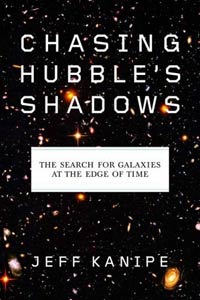|
|
Review: Chasing Hubble’s Shadows
by Jeff Foust
Monday, January 23, 2006
Chasing Hubble’s Shadows
by Jeff Kanipe
Hill and Wang, 2006
hardcover, 224 pp., illus.
ISBN 0-8090-3406-9
US$24/C$32.50
Cosmology—the branch of astronomy that deals with the origin and fate of the universe—is one of the most fundamental areas of research in all the sciences, and also one of the most bizarre. Cosmology tackles some of the biggest questions we can ask (how did the universe begin? how will it end?) yet it can also deal with concepts that are unintuitive, to say the least, to the average person: dark energy, dark matter, inflation, and much more. Putting the current state of cosmology research into a form readily understandable by even an educated layman is nearly as great a challenge as any research problem faced by astronomers, but one handled quite well by science journalist Jeff Kanipe in his new book, Chasing Hubble’s Shadows.
The title of the book comes from a quote by astronomer Edwin Hubble 70 years ago about searches for distant galaxies that pushed astronomers to the limits of telescopes: “There we measure shadows, and we search among ghostly errors of measurement for landmarks that are scarcely more substantial.” Astronomers continue to measure those shadows, using increasingly powerful telescopes that push back the limits of the observable, and thus how far back into the early history of the universe one can see. Ironically, one of the best tools for chasing Hubble’s shadows has been the Hubble Space Telescope. The Hubble Deep Field—a continuous observation of a tiny section of the sky by Hubble over ten days in late 1995—and its successors have allowed astronomers to peer back to less than a billion years after the Big Bang, when galaxies, and the universe itself, did not resemble the conditions we are familiar with today. Hubble and its counterparts, in space and on the ground, have helped astronomers push back the frontiers of research on the early universe to try and understand how and when the first stars and galaxies formed.
Kanipe follows a standard approach in his book, interviewing dozens of astronomers and making the obligatory trip to an observatory—in this case the Keck Observatory in Hawaii—to see astronomers at work. This method might seem formulaic, but the author carries it off well: the result is a broad overview of the current (as of 2005) state of cosmology research, and a glimpse of some of the people and personalities involved in the field, all concisely summarized in a slender book (less than 200 pages, omitting references and index.) Overall, the book is a great way to get up to speed on the current knowledge of, and challenges facing, astronomers in this field.
| If new telescope projects are to win out over competing priorities in astronomy, other sciences, and society in general, proponents will have to work harder than ever to convince government agencies and the public of their importance, a task that may be difficult given the esoteric nature of their research. |
Chasing Hubble’s Shadows does leave unanswered one issue that goes beyond topics like the nature of dark energy and the origins of galaxies. Like many astronomers, Kanipe appears to have a bit of disdain for NASA’s emphasis on human spaceflight: in one part of the book he says that one future astronomy mission, the Beyond Einstein Inflation Probe, might be “derailed by the Moon-to-Mars Initiative proposed by the Bush administration.” Moreover, writing about the Hubble Space Telescope in the first few pages of the book, he is ready to “mourn its probable loss due to a federal budget constraint.” (That is particularly odd since it has been concerns about shuttle safety, not a lack of money, that endangered the telescope; NASA administrator Mike Griffin won a sustained round of applause at the American Astronomical Society meeting in Washington earlier this month when he restated his vow to restore that mission if shuttle safety issues—and not budget constraints—permit.) Yet, in his final chapter, “More of Everything”, Kanipe includes a veritable wish list of projects, including an ambitious set of ground- and space-based telescopes, desired by astronomers who want to push back Hubble’s shadows even more. Such projects do not come cheap: ground-based telescopes can run into the hundreds of millions of dollars, while their space-based counterparts can cost billions. If these projects—deemed essential by astronomers working in the field to further their research—are to win out over competing priorities in astronomy, other sciences, and society in general, proponents will have to work harder than ever to convince government agencies and the public of their importance, a task that may be difficult given the esoteric nature of their research. This makes books like Chasing Hubble’s Shadows all the more important in translating the cutting-edge research of astronomers into a form that helps the public understand the fundamental questions these scientists are trying to answer.
Jeff Foust (jeff@thespacereview.com) is the editor and publisher of The Space Review. He also operates the Spacetoday.net web site and the Space Politics weblog. Views and opinions expressed in this article are those of the author alone, and do not represent the official positions of any organization or company, including the Futron Corporation, the author’s employer.
|
|
